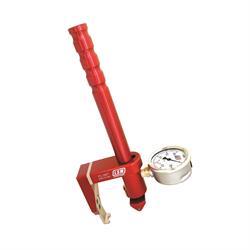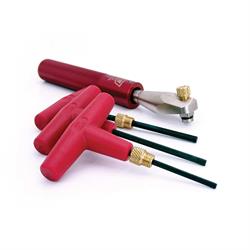Keep Your Sprint Car Engine Running at Peak Performance
One of the most important parts of your racing operation is the engine. In this day and age, having a good engine is important, but knowing how to keep it performing at its peak is one of the keys to success. Here, I will explain the steps that I and many of the top sprint car teams in the country will take in order to keep our power plants on top.
First things first, you will need to wash the car after a race night. As soon as the race is done you will need to pull the hood, remove the mag box and tach, take the stacks and air cleaner off the engine and plug the injectors with Speedway's Fuel Injection Wash Plugs. I also recommend putting sponges inside the tunnels below the plugs. The sponges will absorb any fuel that is left in the injection after shutting the motor down and is a last resort to catch any water that may drip into the tunnels. You will also want to cover the mag with a Scrub Bag or something similar so you do not get water in your electronics. Lastly, clean the stacks and base plate then wash the air cleaner and hang dry.
Once you are finished washing the car and it has dried, you can remove the plugs and sponges making sure not to drop any debris into the injector tunnels. Next, remove the nozzle lines. I suggest taking the engine supply line off the fuel pump and blowing WD-40 up through the nozzles, which will help prevent alcohol corrosion. You can now remove your nozzles and spark plugs. Spray inside the nozzles with brake cleaner and blow with compressed air. I usually hold them up to a light to make sure there is no debris left. Visually inspect the spark plug, spray with brake cleaner and blow dry. Do this while keeping everything with the cylinder it came out of.
It is now time to run the valves. You will want to run the valves after every race night to ensure that nothing has changed in the valve train. If you see a drastic change in valve lash, that is a sign something might be letting loose. The valves can be checked using the Valve Lash Feeler Gauges, and adjusted using the Valve Lash Adjustment Torque Wrench Kit, available at Speedway Motors. Always make sure you set the valve lash to the motor builder’s recommendation. They should have a cold lash recommendation for you and they can be set at the shop.
While running valves, always check the valve spring seat pressure to make sure you do not have a spring going bad. You can do this by using Speedway's Hydraulic Valve Spring Checker. A tell-tale sign that you are about to have a valve train problem is when it shows low seat pressure. When in doubt, swap them out. If you have one going bad and needs changed, it is best to change the whole set. Always double check that you are utilizing an area with no draft, and run the valves after the car is clean to prevent dust or debris from entering the engine.
After running the valves, you can start your assembly process. It is important to pay attention to details. While putting your plugs back in, ensure the threads are coated with anti-sieze to prevent galling, check the plug wires and boots for tears or splits, and check engine fittings to make sure they are tight (especially those pesky valve cover oiler lines, those have bit me before). You can now install the nozzles and nozzle lines, always double check the tightness after they’re put in.
Last thing I always do before installing the stacks and air cleaner is to take some WD-40 and spray all the contact points for the butterflies, inside and outside the runners, throttle linkage heim joints, and basically anything that rotates on the throttle assembly to prevent a stuck throttle situation. Then, even though you may have checked everything once, check it again. Ensure all fittings, valve covers, oil drain plus and filter are all tight. Now you can reinstall the stacks and air cleaner. Last thing to do is make sure the radiator is topped off with water and you are good to go!
When it comes to oil changes, I recommend doing so every 2 – 3 races, depending on where you are racing. If you are racing a big track like Knoxville, Iowa on a weekly basis, change the oil every two race nights. A small place like the now closed Badlands Motor Speedway (formerly Husets) you should change the oil every three nights. When you change the oil, always cut the oil filter a part to inspect for any debris from inside the engine. I also recommend performing a leak down test every time you change the oil. Leak down tests will help determine if you are having and internal failure, such as a bad piston ring, bent valve, head gasket failure, etc.
Keep track of the time that has been put on the engine. Many motor builders will have a recommended time frame as to when they want to have the motor back in their shop for a freshen. Some will want you to keep track of the number of races; others will want you to keep track of laps. If a motor builder for a 360 tells you they want it back in 20 races, I would highly recommend sending it back after 20 races, even if everything checks out good. If your 410 builder says they want it back every 650 laps, make sure you count every lap.
If hot laps run 4 laps, 2 lap time trials, 8 lap heat race, and 20 lap feature, you put 34 laps on the engine. I always keep track of this on the valve cover, so if you have multiple engines it is easier to keep track of every engine’s status. It is also great practice to put new Valve Springs in every 8-10 races. I have never ran a set of valve springs more than 10 races, even if they check out good. I consider it cheap engine insurance.
When you have multiple engines and you are swapping an engine then letting one sit for a while, make sure everything is lubricated before you take the engine out. An example would be if you run an engine in May or June and decide you want to save it for the Knoxville Nationals in August. After you get it serviced and ready to pull out, keep the plugs out and spray a couple squirts of Marvel Mystery Oil in the spark plug holes. Then, run the engine back and forth a few rotations to coat the cylinder walls. You can also take the rocker arms off of the heads so you do not keep the valve springs compressed for too long causing an out of tune valve train.
Lastly, pay attention to all the details. The biggest thing that the top teams have going for them is their attention to detail. If you do that, as well as take all the steps that I listed above and adhere to recommendations from your motor builder, your engine should last you for quite some time without seeing very much power loss.



